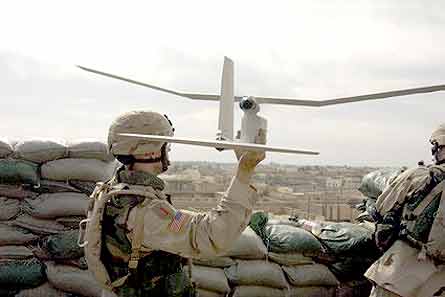California-based AeroVironment is warning of continued volatility in the small unmanned air vehicle (UAV) market with increased competition likely as the segment continues to undergo rapid technological shifts coupled to changing customer requirements.
The firm says the sector is increasingly becoming a focus for established defence contractors domestically and internationally, which is placing new pressures on its existing dominance in the US market.
AeroVironment is reporting a compound annual growth averaging 71% over the past three years, the bulk of which has been driven by small unmanned air system (UAS) orders from the US military.
However the firm has also revealed it secured two commercial service contracts in October to carry out oil and gas pipeline and offshore production platform monitoring as part of efforts to widen its market base.
Aerovironment commenced trading on the US NASDAQ technology index 23 January with an initial offering of 6.7 million shares at $17 per share. Trading for the week closed at $23.16.
According to the company’s prospectus, the small UAS segment will remain a core focus for future growth. It says: “We intend to increase the penetration of our small UAS products within the US military, the militaries of allied countries and non-military US customers. We believe that the increased use of our small UAS in the US military will be a catalyst for increased demand by allied countries, and that our efforts to pursue new applications will help to create non-military opportunities”.
The company is also flagging plans for high levels of reinvestment in its core technologies as well as significant commercialisation outlays to help secure new market penetration, saying: “We plan to incur substantial research and development costs as part of our efforts to design, develop and commercialise new products and enhance existing products. We spent $16.1 million, or 12% of our revenue, in fiscal year 2006 on research and development activities.”
It identifies the US homeland security market as a near-term opportunity as “non-military government agencies and commercial customers continue to explore the potential of small UAS technology to a variety of needs such as border surveillance and infrastructure monitoring. One example of a current non-military government customer for small UAS is the Federal Bureau of Investigation. In addition small UAS are currently being tested for potential domestic application on the US-Mexico border.”
The commercial market for small UAS is “in the early stages of development” by the company. It explains: “To date our primary focus has been to address military demand for small UAS and we have only recently begun to pursue commercial applications actively. Since these markets traditionally have not been served by small UAS we believe it will take time to educate potential customers about these products.
“We intend to lever the experience of our flight training organisation to provide new operating services to commercial customers. We have performed multiple commercial demonstrations to date and recently executed our first service agreements with commercial customers”.
Key competitors identified by the prospectus include Advanced Ceramics Research, Applied Research Associates, Elbit Systems, L3 Communications and Lockheed Martin. “We do not view large UAS such as Northrop Grumman Corporation’s Global Hawk, General Atomics Predator, the Boeing Company’s Scan Eagle and AAI Corporation’s Shadow as direct competitors because they perform different missions and are not hand-launched and controlled, although we cannot be certain that these platforms will not become direct competitors in the future.”
As the overall UAS market expands, “we expect that competition will intensify as additional competitors enter the market and current competitors expand their product lines”.
In parallel the prospectus warns that if the UAS sector fails to “experience significant growth, if we cannot expand our customer base or if our products do not achieve broad acceptance, then we will not be able to achieve our anticipated level of growth”.
UAS activities accounted for 80% of AeroVironment revenues for the US fiscal year ending 30 April 2006, generating $111.1 million out of a total of $139.3 million. UAS revenues for the half year to 28 October 2006 reached $62.8 million out of total company revenues of $76.7 million.
Total international UAS sales by the company comprised just 0.3% of revenues for the year ending April 2006, representing a decline in non-US sales over the past three years. Total international sales in the year ending April 2004 amounted to 6.4% of revenues, falling to 2.4% of revenues in 2005. AeroVironment says that it is stepping up its international sales effort with representatives now in place in Australia, Canada, East Asia, Europe and the Middle East.
Actual international customers identified by the prospectus comprise Australia, France and Italy. Australia acquired a single Raven system in a A$480,892 ($375,000) deal signed May 2004 with deliveries completed in June 2005.

Firm forward US military orders were worth $64 million as at 28 October 2006.with an unfunded, indefinite order backlog worth up to $495 million Those orders are dominated by ongoing Raven system production for the US Army, with a total anticipated requirement for 1,900 systems, of which 25% had been contracted and delivered by fourth quarter CY2006.
In turn, the US military is developing new revenue opportunities for the company via logistics support requirements. The prospectus says that up to 30 April 2006 “our logistics operations accounted for 21% of our revenue”.
Source: FlightGlobal.com























